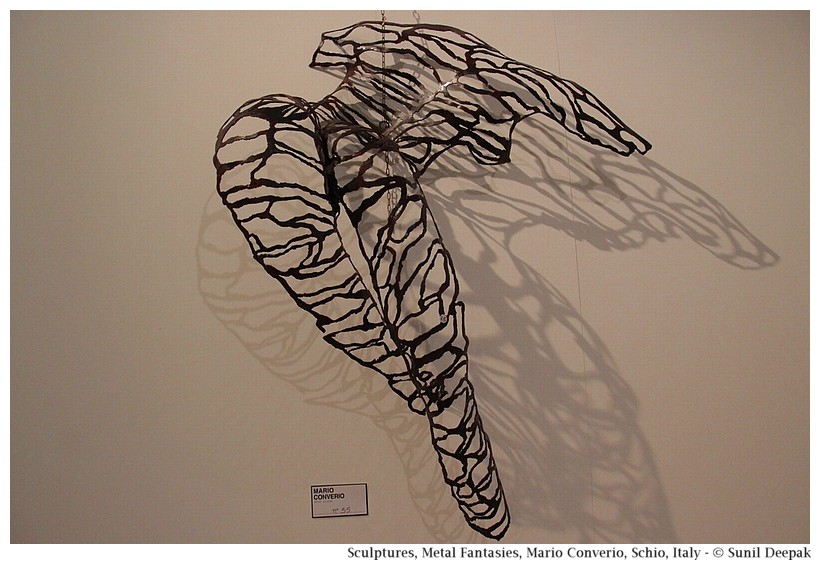Let me now present some other works that I liked in this exhibition.
A sacred geometry by Karen Oremus (Canada/UAE)
Karen had created this work by cutting shapes in the paper with a laser and then stacking those papers over one another. This led to the creation of two kinds of towers - a downward going gentle tower/well that reminded me of the geological configuration of the Echo point near Munnar in Kerala, India. The other was a tower rising up in the air.
Domestic intimacy by Alexio Minini (Italy)
Alexio used paper and the origami to create a dancing old couple. The paper folds were very effective in creating wrinkles and screwed-up eyes on the faces of the dancers. (Click on the image for a bigger view)
At home by Maurizio Corradin (Italy)
Maurizio, an art therapist, had made a huge installation of a dome using paper, plastic, coloured LED lights and painting. The image of this work that you will find below shows the close-up of one of the sculptures near the bottom of the structure so that you can appreciate the kind of work that had gone in creating it.
Overall, I found the installation to be a little gimmicky for my taste and it did not evoke an emotional response in me. However, I did appreciate some of the details of this work.
House of my mind by Daniela Camuncoli (Italy)
Daniela is known for her paper collage work. She had made a wonderful collage of a young woman with earnest blue eyes that I loved for its colours, form and textures. I thought that it was unpretentious, clean and direct. It also had a charm in it that made me stand there and look at it for a very long time.
Some other Paper art installations
In the first part of this post presenting some works from a previous Papermade exhibition, I had explained that I am not fond of use of computers to create art - I feel that it is a kind of cheating. However, I also agree that my attitude towards digital art is a bit irrational - digital art is probably the future of art and artists need to have the freedom to use the medium they like for their art-expression.
Here are some other installations from the Papermade exhibition, which were good but at the same time, were based on a more traditional use of paper.
The first of these was a work called "Over confidence" by the Italian artist Alberto Balletti. It had been produced by an ink-jet etching. It showed a nude couple, probably in their fifties or sixties, who seem to be lying close to each other and yet distant, lost in thoughts with a kind of defeated look on their faces. I am not sure why the artist has named it "over confidence". Can anyone explain?
Acathexis is a psychoanalytical term used for persons who are unable to feel and show emotional responses. I think that probably this work showed Israeli persons who have been desensitised by the long on-going war with the Palestinians.
I like Papermade art when artists use paper as a building material through papier-mache, collage, assemblage, origami or paper-cutting, and not just use it to print or paint something. In the last Papermade exhibition, there were not so many examples of such use of paper to create art. Most of the works had used paper to print or paint. Thus, I was a little disappointed. However, I loved two works - House of my mind and In your arms.
If you had missed part 1 of this post about a previous Papermade exhibition, you can also check it.
***

























































